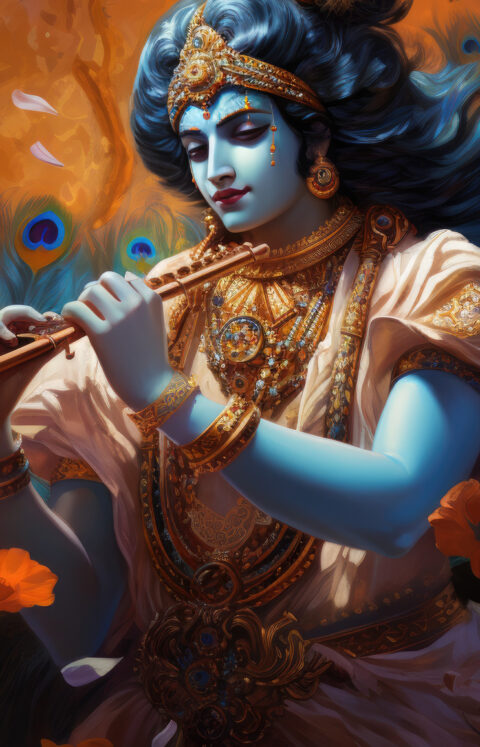The Bhagavad Gita is essentially the voice of God. It is the voice of Lord Krishna teaching the circle of life to Arjuna in the battlefield of Kurukhetra. It is a matter of realization for us that God has spoken about life and its doctrine of things which reflect in this universe in each step of our life. The truthfulness of those words are realized in our daily life. The Vaishnava philosophy has expressed a concept of man to God and vice verse in the form of Nara-Narayana. Here Nara is the human soul that reunites with God. Narayana is the divine soul that is present in humanity as well. And in the Gita we realized that God is reunited as a friend with the human soul. There are 18 chapters in the Gita, and it contains 700 verses. The plot started with the battle of Kurushetra was going to start and Arjun is the fighter in the chariot with the divine Krishna as his charioteer. But seeing his relatives all around Arjun gave up the hope to fight the battle. Lord Krishna explained the cycles of human life, the Karma and his results. This gave the courage back to Arjun to fight the battle. Sri Krishna explains that a person must avoid the respective traps of the three gunas: rajas (anger, ego), tamas (ignorance, darkness), and saatva (harmony, purity). The main goal that Gita teaches us is self-realization and unite with God.
tat tvam asi, (Sanskrit: “thou art that”) tells the relationship between the individual and the Absolute. The statement is frequently repeated in the sixth chapter of the Chandogya Upanishad. Bhagavad Gita represents the 3 parts as well.
The first part of Gita (Tvam) talks about challenges that human beings face. It is important to know the purpose of life. Duty has to be performed, that is karma yoga – path of action.
The second part (Tat) explains the SUpreme Reality that is God, Sri Krishna who is ultimate and everything. Lord Krishna shows Arjun his Viswaroopa which includes everything.
The third is (asi) which is the relationship between God and the individual. The three gunas – tamas, rajas, and sattva, are part of this world and we are binded. Gita tells that one can be a true Self when he goes beyond the three gunas.
Gita tells us that the body is unreal. It is a mere covering so one should not be judged by his outer look but the inner Self which is our true identities. Our mind is filled up with desires and is unstable. Gita suggests that one should attain inner peace and tranquility to get a chance to unite with God.
By only controlling your mind one cannot free from the cycle of birth and death. One has be free from desires to achieve uniqueness and reunite with God. But one to perform his duties without any expectations and desires, this is Karma Yoga. Knowledge and the fire of wisdom can make oneself reunite with God. Our life should have the ability of renunciation, meaning giving up the world. To become one with God it is important to live and die for the sake of God, self control of everything is important. Gita says that a sannyasi is above all these attachments. He is equal minded and does not feel human emotions like pain, sorrow, hot, cold etc. He is in a higher state to become one with God. Gita refers to God and Self as the same aspects. At the time of death one should think of God and the savior liberates him. It is important to surrender to God. Gita describes the keeping of faith and worship only the supreme Brahman is desired to attain the ultimate peace. Lord Krishna states that with pure devotion and things of him he takes care of those who think of Him. One can realize the best of all the yogas to achieve the four aims of human life, namely Dharma, Artha, Kama and Moksha, without risking liberation or incurring sinful karma. Gita explains that the main solution of overcoming this problem is detachment, the more you get detached from desires the more you come near to God.
The Bhagavad Gita emphasizes three steps. First is Karmayoga, the selfless sacrifice of works. The second is Jnanayoga, the self-realization and knowledge of the true nature of the self and the world. The third step is Bhaktiyoga, seeking of the supreme Self as the Divine Power and focus on devotion.
Inspiration : Essay on the Gita by RIshi Aurobindo
https://www.speakingtree.in/article/a-short-summary-of-the-bhagwad-gita
https://www.hinduwebsite.com/summary.asp
Image Contribution : <a href=”https://www.freepik.com/free-ai-image/painting-representing-krishna_94071275.htm#page=2&query=gita&position=9&from_view=keyword&track=sph&uuid=829499b9-03da-4749-8eea-42556b35e75c”>Image by freepik</a>


